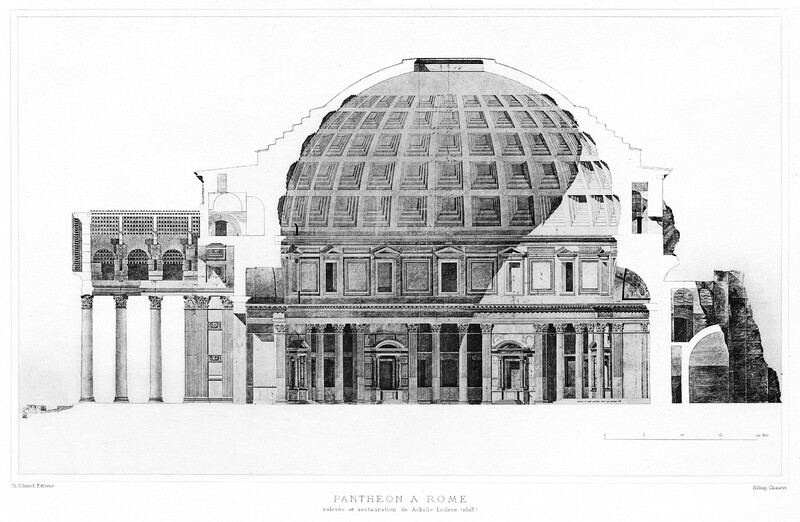Pantheon
Item
- Title
- Creator
- Drafter
- City
- Address
- GPS
- Location
- Building Creation Date
- Century
- Description
- Classification
- Building Type
- Documentation Type
- Style/Period
- Cultural Context
- Subject
- Source
- Access Rights
-
Pantheon
-
Hadrian, Emperor of Rome (Roman patron, 76-138 CE)
-
Heliog J. Chauvet
-
Rome, Lazio, Italy
-
Regione IX Circus Flaminius
-
Piazza della Rotunda
-
54.3754
-
Italy
-
27 BCE-128 CE (creation)
-
1st century BCE
-
1st century CE
-
2nd century CE
-
current section, sections
-
Commissioned by Marcus Agrippa (that building destroyed, but referenced in the inscription), and completely rebuilt by Emperor Hadrian ca. 118-125 CE. The building is circular with a portico of large granite Corinthian columns (eight in the first rank and two groups of four behind) under a pediment. A rectangular vestibule links the porch to the rotunda, which is under a coffered, concrete dome, with a central opening (oculus of 8.15 m diameter) to the sky. Almost two thousand years after it was built, the Pantheon's dome is still the world's largest unreinforced concrete dome. The height to the oculus and the diameter of the interior circle are the same, 43.3 metres (142 ft). It is one of the best preserved of all Roman buildings. It has been in continuous use throughout its history, and since 609, the Pantheon has been used as a Roman Catholic church dedicated to St. Mary and the Martyrs (Santa Maria ad Martyres) but informally known as "Santa Maria Rotonda."
-
Architectural Documentation
-
sections
-
Imperial (Roman)
-
Roman
-
architecture
-
death or burial
-
funerary art
-
rulers and leaders
-
Roman Empire
-
Seure, Georges. Monuments antiques, relevés et restaurés par les architectes pensionnaires de l’Académie de France à Rome
-
notices archéologiques par Georges Seure. Paris: C. Massin, 1910, 137.
-
Public Domain
- Item sets
- Architecture Illustrations
Hadrian, Emperor of Rome (Roman patron, 76-138 CE), “Pantheon”, Arch Design Images, accessed October 7, 2025, https://exhibits.lib.ttu.edu/s/archlib/item/18840


